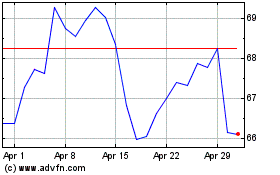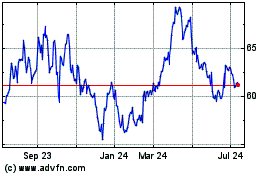By Erin Ailworth
America's oil and gas producers are still finding places where
they can prosper even at today's lower prices.
Companies are refocusing their drilling efforts on the Permian
Basin in Texas and New Mexico and rushing into a part of Oklahoma
known as the Stack where they can claim solid returns. While small
in terms of overall production, the move is gathering steam, even
as drilling in places like North Dakota and Pennsylvania remains
sluggish.
Wells in the Permian and the Stack -- which stands for Sooner
Trend, Anadarko basin, and Canadian and Kingfisher counties -- are
racking up between 10% and 30% returns based on oil priced at $45 a
barrel, operators say; premium wells are generating greater
profit.
In part, returns benefit from access to established pipeline,
storage and other infrastructure. Drillers in both areas have been
able to find energy stacked in layers underground. Some producers
also are tapping holdings that were acquired long ago, when
acquisition costs were lower.
Continental Resources Inc., which helped spark the North Dakota
boom, says its best wells today are in the Stack -- a well-trod
part of Oklahoma near Cushing, Okla., a major oil storage and
trading hub. The company says its drilling there can yield a 75%
return with oil at $45 a barrel. The company recently announced a
gusher of a well in the field.
"These wells are among the best-performing wells I've been
involved with in my entire career," Harold Hamm, Continental's
chief executive, told investors last month. Of the 57 rigs
currently drilling in Oklahoma, about half are in the Stack, and 11
of those are Continental's, the company said.
As U.S. oil futures, which closed on Friday at $48.62 a barrel,
rebounded and recently approached $50 a barrel, some large and
midsize energy companies have said they are planning to step up
production in lower-cost areas. The gains aren't likely to tip the
scales toward greater production or hiring nationwide, but they are
tempering some of the decline elsewhere.
"Now we're talking about plays that can break even or do better
at $45 oil," said John Freeman, an energy analyst at Raymond James
& Associates.
Another area where production is still rising is the Permian
Basin, which spans parts of West Texas and New Mexico.
The Permian, a major oil-producing area for decades, has been
reborn as the combination of horizontal drilling and hydraulic
fracturing have helped companies tap oil trapped in dense rock
formations. Operators there now pump more than 2 million barrels of
oil a day, more than in any other U.S. drilling region, according
to estimates from the U.S. Energy Information Administration.
The Permian's low production costs are luring companies like
Occidental Petroleum Corp. away from other fields. Vicki Hollub,
Occidental's chief executive, recently told investors that the area
would be the company's highest priority.
"We feel like that is where we get the most value for the
dollars we invest," she said.
Pioneer Natural Resources Co., currently the most active driller
in the Permian, said it is planning to add more rigs to its
operations -- one or two at a time -- when oil prices hit $50 a
barrel.
Chevron Corp. said it has identified some 4,000 wells in the
Permian that can generate a 10% return at that price, as well costs
in the area have fallen even as output increases.
"We see our activity in the Permian as being very, very,
strong," Joseph Geagea, Chevron's executive vice president of
technology, projects and services, told investors in April.
The fortunes of these areas could change as quickly the old
ones. Just a few years ago, energy workers were streaming into
North Dakota, pushing rental prices sky high and spawning hotel
construction as they looked for work on or around one of the more
than 200 rigs drilling in the Bakken Shale formation.
Today, energy is still drawing workers to places like El Reno, a
city of roughly 20,000 about 30 miles west of Oklahoma City, where
Halliburton Co. has an office and repair facility.
"Our motels are still pretty much full," said El Reno Mayor Matt
White. "We really are excited about the energy play out here. It's
a big deal for us."
PayRock Energy LLC, a private-equity-backed outfit that buys
acreage to drill and flip, said there has been so much interest in
its Stack property that the company has put all its 58,000 acres on
the market.
"Little guys, private guys, public guys, in-basin guys,
out-of-basin guys -- you name it," said John Zimmerman, PayRock's
vice president of finance. "Everybody who is in the Stack wants
more of it."
Case in point: Newfield Exploration Co. recently paid $470
million to Chesapeake Energy Corp. for more than 40,000 acres that
complement its existing footprint in the Stack. The Texas-based
energy explorer has shifted most of its activity to Oklahoma, where
it will spend 90% its $650 million budget this year.
Newfield has just one rig now running in North Dakota's Bakken
region, and has deferred all drilling in Utah and South Texas. Even
when prices rise, the company is most likely to increase activity
in Oklahoma first.
"The industry has really voted with its checkbook," said Stephen
Campbell, a Newfield vice president.
Write to Erin Ailworth at erin.ailworth@wsj.com
(END) Dow Jones Newswires
June 05, 2016 17:51 ET (21:51 GMT)
Copyright (c) 2016 Dow Jones & Company, Inc.
Occidental Petroleum (NYSE:OXY)
Historical Stock Chart
From Mar 2024 to Apr 2024

Occidental Petroleum (NYSE:OXY)
Historical Stock Chart
From Apr 2023 to Apr 2024
